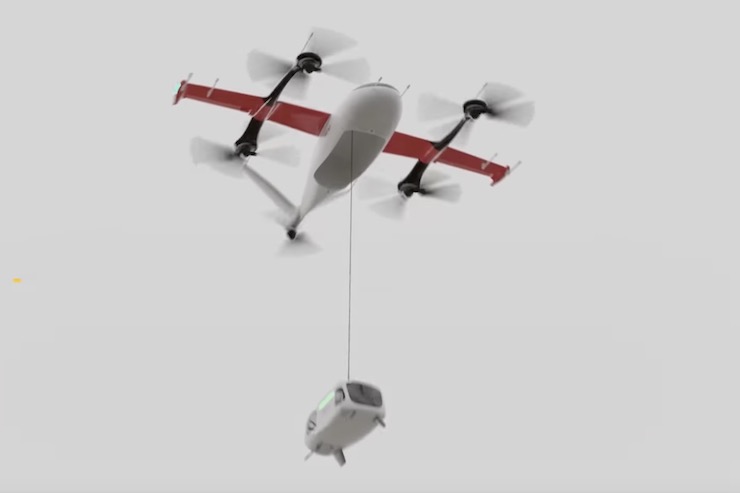
Deep cuts in the workforce levels at Walmart and Amazon have industry observers worried about the future of the two companies’ massive investments in drones as a sustainable alternative to road-based vehicle deliveries.
The trouble began last January when Amazon announced plans for a major reduction in its headcount, the largest in the company’s history. While these cuts are scheduled to affect Amazon across the board, industry sources say the company has specifically targeted its under-performing drone division – and just as the company was preparing to launch its long-delayed aerial delivery operations in Lockeford, CA and College Station, TX.
The staffing cuts are deep. At the company’s Oregon test center, for example, half the workforce has been let go, according to a Linked In posting by an Amazon employee that has since been deleted. Other sources have noted a sudden listing of nearly 60 open positions at the Oregon test center and other Amazon locales.
Amazon’s chief retail competitor, Walmart is also facing pressures to reduce its drone-related work force. In this case, the cuts may be mostly affecting the operations of its prized UAV contractor, DroneUp, which oversees drone deliveries for Walmart at 36 store outlets in six US states, including Arkansas, the company’s corporate headquarters.
DroneUp, which announced the pending lay-offs last week, has portrayed the cuts less as a pull-back or downsizing than as a “repositioning. “ Henceforth, the company plans to abandon its partnerships in construction, farming and other leading drone sectors and focus exclusively on its partnership with Walmart, DroneUp officials say.
Still, the announcement has some investors jittery. Walmart recently launched new drone delivery operations in Florida and Virginia and has promised investors and stakeholders that its delivery operations will expand rapidly over the next two years. So far, the company has made just 6,000 deliveries from its 36 store sites, an average of just 175 per site, despite months of preparation that began well over a year ago.
DroneUp’s decision to focus on retail delivery operations may be an attempt to assist Walmart to expedite store deliveries that have fallen far short of expectations. DroneUp insists that the layoffs are a short-term adjustment and that more workers will be needed in the future, but no timetable for additional hiring was announced, leaving investors concerned.
Amazon continues to face obstacles to the expansion of its own drone deliveries, a problem that has plagued the company from the beginning. Former company CEO Jezz Bezos first announced his bold drone vision on national television back in 2013, but recurring technological and safety issues have delayed even pilot testing, until earlier this year.
Even with a tentative go-ahead from the Federal Aviation Administration, the FAA still insists that all Amazon drone deliveries be rigorously monitored in flight, with ground observers pausing Amazon deliveries as they prepare to cross major thoroughfares.
The FAA’s safety restrictions, plus persistent mechanical issues, appear to have limited Amazon’s ability to fulfill customer orders promptly. So far, just 100 orders have been filled at its two pilot delivery sites, company records show.
In fact, this is not the first time Amazon has been forced to reduce the headcount in its drone division. Significant layoffs also occurred in 2020 when the company was forced to seek outside technical help to improve the design and operational performance of its drones. However, the most recent cuts are far deeper, sources say, affecting Amazon’s entire robotics and engineering divisions.
The two companies aren’t alone in facing pressures to downsize. The entire drone industry has witnessed a 40% reduction in new investment between 2021 and 2022, giving all stakeholders pause to regroup. But the current level of investment still surpasses the level recorded for the entire 2018-2020 period, according to financial data, which is suggestive of the industry’s underlying strength and future potential, sources say. But some companies, including Walmart and Amazon, appear to be more vulnerable to contraction.
Other drone delivery companies, including Zipline and Wing, do not appear to be facing the same pressures. Zipline has just entered the food delivery market after years of success with remote medical delivery operations, primarily in Africa. Wing has made thousands of successful store deliveries in Australia and New Zealand and recently established one of its 10 global drone hubs in the Dallas-Fort Worth area.
Given their track record and industry standing, and their ongoing support from the FAA, both companies would be poised to exploit whatever void might open up in the US market should Walmart and Amazon continue to falter.
Still, both retailers might find fresh opportunities elsewhere. The two companies have begun competing fiercely for control over aerial cargo deliveries in India, where the market still relies heavily on conventional aircraft and road vehicles.
So far, neither Walmart nor Amazon has moved to exploit what could prove to be a highly lucrative opening in India’s rapidly developing drone industry but both companies are unusually well-positioned to do so – and likely will, as the drone market continues to evolve.
|